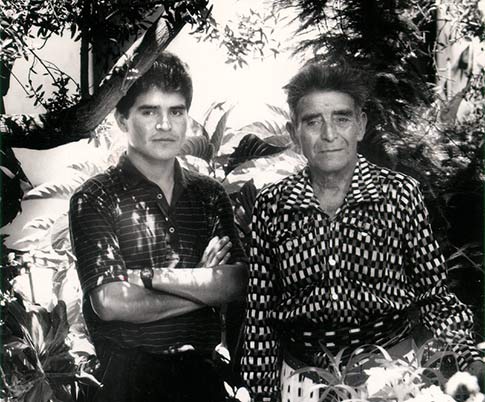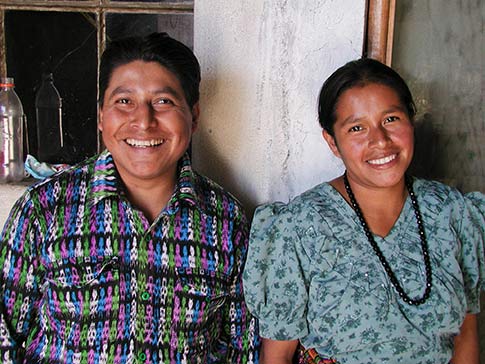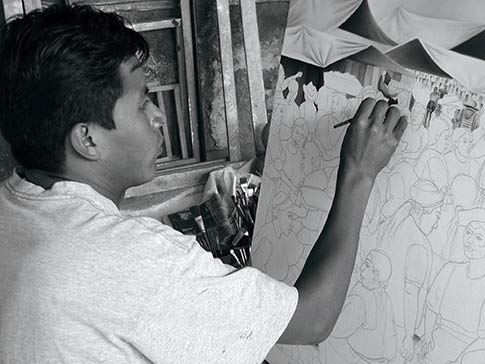The Paintings of
José Antonio
González Ch.
Juan González Chavajay
Domingo Rocché Rodriguez
Manuel González Quiacain
Artist Biographies
San Pedro la Laguna
Rafael González y González
Pedro Rafael
González Chavajay
Lorenzo González Chavajay
Mariano & Matías
González Chavajay
Juan Fermin
González Morales
Vicenta Puzul &
Maria Teodora Mendez
Domingo Garcia Criado
Mario González Chavajay
Chema Cox &
Edwin González
Emilio & Lorenzo
González Morales
Samuel Cumes Pop
Miguel Sunu &
Bartolo Quiacain
Marlon Puac
Four Other Pedrano Artists
José Antonio
González Escobar
Manuel González Quiacain
Manuel González Quiacain is a true artist in every sense. He is involved in recording and preserving every part of the cultural heritage of the Tz’utuhil Mayan people and especially the culture of his town San Pedro la Laguna. His family is descended from the first non-Mayan person to marry into the town, and as such they had the first colonial house in the town. Outside of the catholic church they had the most relics in their private chapel. When the local priest decided to destroy all the “graven” relics, Manuel was able to save some of these cultural treasures from being burned. When his family converted to a fundamental religion he negotiated the gift of the 200-year-old carved-and-painted wooden image of Christ on the cross to another side of the family who remained Catholic. He has recorded many old Tz’utuhil Mayan stories. When embroidered “paintings” became popular with the tourists, Manuel created one with the finest embroidery, unequaled in quality by any in the markets.
For a couple of years in the early 1990s, Manuel tried painting. Most of his paintings were small portraits of San Pedro women. Unlike the generic people in other San Pedro artist's paintings, Manuel's people were easily identifiable individuals. Although I always encouraged him and promised to buy his paintings, he gave up painting. His family did not appreciate his artistic/cultural bent and pushed him into more mundane occupations where he could earn regular money. When the family compound was remodeled with space for storefronts across from the town market, Manuel received one of the storefronts. He opened a cantina, but his heart was not in this sort of enterprise. He finally settled into teaching school. Every morning at five a.m. he takes the boat to Santiago Atitlán where he inspires his students with his vast knowledge of the Maya culture.
Juan González Chavajay
Juan González Chavajay was one of the first artists I met in San Pedro. At my request in 1988, woodcarver Vicente Cumes Pop took me to the homes of five painters who lived in San Pedro: Pedro Rafael González Chavajay, Matías González Chavajay, Chema Cox, Domingo Garcia, Mario González Chavajay, and Juan González Chavajay. Juan had an older brother, an outspoken poet, who Juan admired very much. This brother had been silenced by the death squad during the time of violence. His brother had encouraged him to paint. Juan’s family ran a small printing business in San Pedro. Gradually over the next five years the printing business began to take up more or Juan’s time, until Juan stopped painting in the early 1990s.

Juan González Chavajay in the garden beside their print shop and home. His father wears the traditional hand-woven San Pedro men's shirt. The men Juan's age typically neither own or wear such a shirt except for special occasions. The garden, like most gardens within the town, has been replaced with a new concrete block building of several stories.
José Antonio González Chavajay
José Antonio González Chavajay, a younger brother of Pedro Rafael and Mario, decided to take up painting around 2000. He learned from his brother Mario who at that time lived next door to him. Whereas Mario had struggled to find his own style, José Antonio learned easily. Mario introduced me to his brother, and I bought a couple of very nice medium sized paintings. I tried to work with José Antonio, but he spoke very little Spanish, and seemed more interested in earning money as quickly as possible rather than becoming an artist. I offered to buy all his paintings rather than him having to paint for the tourist market, but within a few months of this offer, José Antonio left San Pedro for the United States.

José Antonio González Chavajay with his wife in front of their small home.
Domingo Rocché Rodriguez
Domingo Rocché Rodriguez is a good painter, better than many in San Pedro. He has contacts with galleries in New Mexico, and he ears a good living selling his paintings through them in the United States. Unfortunately, many of his paintings are not his own ideas or his own compositions. He showed me a book of photographs of his paintings, and I recognized too many of them as copies of original works by other artists images of which were posted on the Arte Maya website. The one painting in the Arte Maya collection by Domingo is, I am told by his friend and neighbor Vicente Cumes Pop, a copy of a painting by Vicente's brother Samuel Cumes Pop, which from the theme has a strong ring of truth.

Domingo Rocché Rodriguez works on a large canvas containing many individuals. Unfortunately, many of his paintings are not his own ideas or his own compositions.